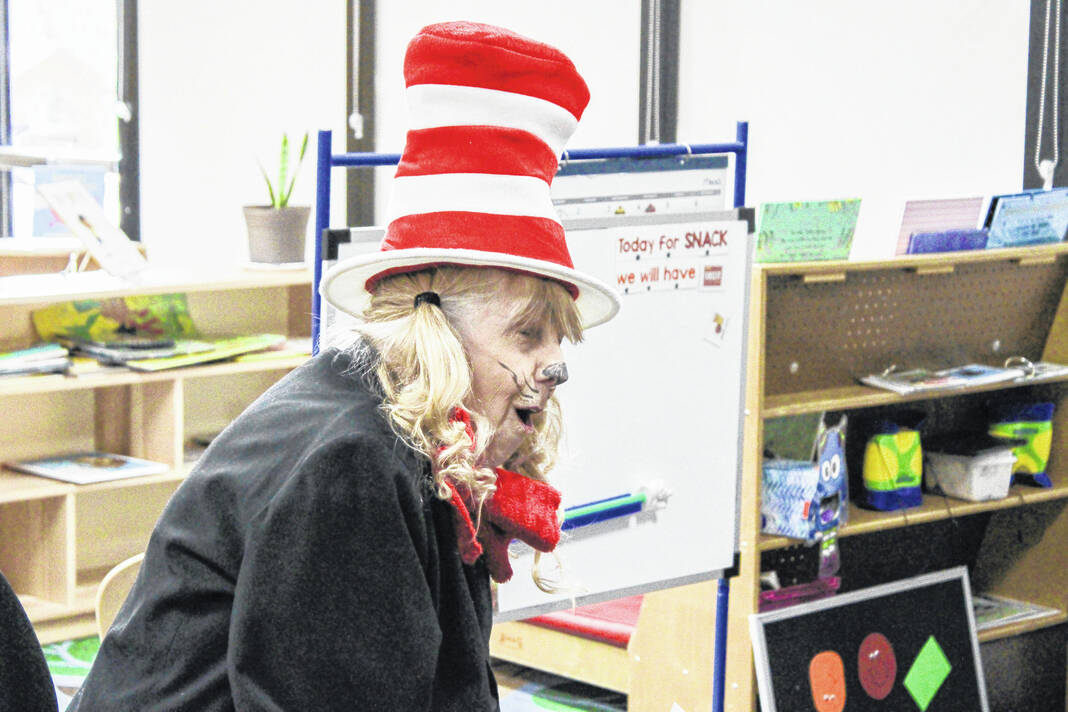
Submitted photo | Vivian Blevins

Book banning is all the rage among some politicians now, but I’d suggest if you are curious about any titles on their lists, just go to your public library, read the book in question, and make the decision yourself.
As a college professor, I have had the privilege of teaching children’s literature, as well as courses in the methods of teaching reading, to elementary education majors.
Last week, I had the opportunity to read to the pre-school children at Edison State Community College’s Child Development Center. I considered what might appeal to them, and since I’ve always loved Dr. Seuss’ classic The Cat in the Hat, I opted for that title.
I ordered the book, paper hats depicting the cat for the 16 children, and cheddar cheese fish snacks. Those of you who know the story are aware that the fish is the voice of moral authority in the tale, and the cat operates outside of acceptable norms with no regard for private property and has two sidekicks, Thing One and Thing Two, who help him wreak destruction. Sally and her brother, who is the narrator and gives voice to the story, are observers of the action. At the conclusion of the story, the brother poses an ethical question to the readers regarding whether or not to tell their mother about the destruction that went on at their home: “Should we tell her the things that went on there that day? Should we tell her about it? Now, what SHOULD we do? Well… What would YOU do if your mother asked YOU?”
By now you’re saying, “Vivian (I introduced myself to the three- and four –year-old children as Granny Viv), surely you didn’t use that terminology with those little folks.”
No, but allow me to describe my 20-minute session with them. When I walked through the door of the center carrying a red suitcase, the children were gathered at the stage waiting for my arrival. They began to smile, talk and point at me. Why? I was wearing a black pants suit with a BIG red bowtie, big red shoes, and the red-and- white tall stovepipe hat as presented in the book. I also had used a marker to blacken my nose and draw whiskers on my face, kind of like a real cat.
And the session began with my getting them involved, encouraging them to talk, to learn from each other with my questions about cats: Do you have one, real or stuffed? What do you feed your cat? Is your cat allowed to sleep on your bed? Do you take your cat for a walk? Do you take him/her to the vet for teeth cleaning or illness? Does your cat have toys? What kind?
They responded eagerly, that is, they were developing their language skills. And when one little fellow said that male cats don’t have long hair like mine, another little guy corrected him and told him that some boys do, in fact, have long hair.
When I realized that the story was too long for these little ones, I began to improvise. I concluded with the question in the book, “If this happened to you, would you tell your mother?” Most answered in the affirmative and two or three said they wouldn’t tell. This gave me the opportunity to stress the importance of always being honest with parents.
As the director of the center, Holly Short, began putting the hats I had brought on the children, three little girls came up and hugged me, followed by little boys who wanted to try on my hat.
Why have I told you about this little incident? Reading is fun and it’s fundamental. If your child can read and can read well, he/she can master any subject. Buy books; read to your kids every single day (Five minutes can have a very positive impact); take your kids to the public library.
Become the teacher in your home. You say, “What! Me? A teacher?” Textbooks say that the following are approaches to teaching reading: phonics, guided reading, sight words, linguistic, language experience, multisensory.
I’m going to break it down into plain English, and I know you can do this:
Talk to your children and help them understand that the words we speak are also on the printed page.
If words relate to the senses, let them know with your body language and facial expressions. Examples, smelly, rough, sharp.
Let your children tell you simple stories about their day and type the stories, date them, print them, and put them in a binder or notebook. Kids never tire of hearing the story about the day they got a puppy or saw a bluebird at the feeder. And they love the classics: Cinderella, Goldilocks and the three bears.
There are small words that are called sight words, and kids memorize them. Print them on index cards. Examples: is, are, in, of.
Print the names of objects in children’s bedrooms on index cards and place them on or by the object. Examples, doll, bed, bear, chest, curtain, floor.
Most children learn to sing the alphabet song. Play with sounds with them so they understand that letters of the alphabet make speech sounds.
Encourage children to use context clues or illustrations in the book when they come upon words that they don’t know. Let them guess.
In terms of the index cards, you need three stacks with rubber bands: words they have learned, words that they recognize sometimes, and words that are unfamiliar to them. Keep adding new words to the piles and move words as they master them to the appropriate pile. This becomes a concrete record of their progress.
Can you do it? Is it worth your time and effort? Absolutely.
Vivian B. Blevins. Ph.D., teaches telecommunication employees from around the country and students at Edison State Community College and works with veterans. You may reach her at 937-778-3815 or [email protected].


